
Gerard David was an Early Netherlandish painter and manuscript illuminator known for his brilliant use of color. Only a bare outline of his life survives, although some facts are known. He may have been the Meester gheraet van brugghe who became a master of the Antwerp guild in 1515. He was very successful in his lifetime and probably ran two workshops, in Antwerp and Bruges. Like many painters of his period, his reputation diminished in the 17th century until he was rediscovered in the 19th century.

Visual art of the United States or American art is visual art made in the United States or by U.S. artists. Before colonization, there were many flourishing traditions of Native American art, and where the Spanish colonized Spanish Colonial architecture and the accompanying styles in other media were quickly in place. Early colonial art on the East Coast initially relied on artists from Europe, with John White the earliest example. In the late 18th and early 19th centuries, artists primarily painted portraits, and some landscapes in a style based mainly on English painting. Furniture-makers imitating English styles and similar craftsmen were also established in the major cities, but in the English colonies, locally made pottery remained resolutely utilitarian until the 19th century, with fancy products imported.
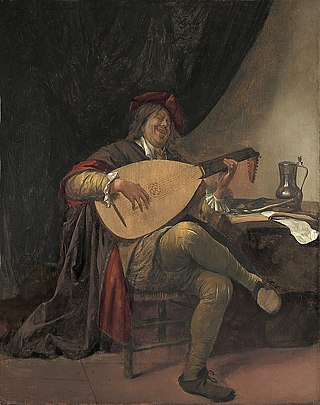
Jan Havickszoon Steen was a Dutch Golden Age painter, one of the leading genre painters of the 17th century. His works are known for their psychological insight, sense of humour and abundance of colour.

George Caleb Bingham was an American artist, soldier and politician known in his lifetime as "the Missouri Artist". Initially a Whig, he was elected as a delegate to the Missouri legislature before the American Civil War where he fought against the extension of slavery westward. During that war, although born in Virginia, Bingham was dedicated to the Union cause and became captain of a volunteer company which helped keep the state from joining the Confederacy, and then served four years as Missouri's Treasurer. During his final years, Bingham held several offices in Kansas City, while also serving as Missouri's Adjutant General. His paintings of American frontier life along the Missouri River exemplify the Luminist style.
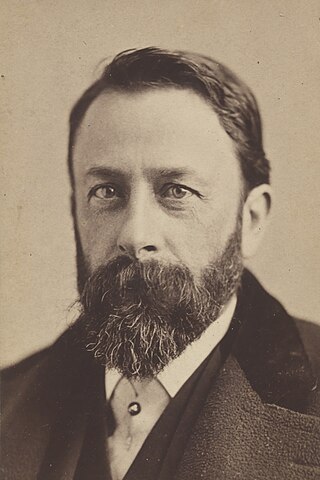
Albert Bierstadt was a German American painter best known for his lavish, sweeping landscapes of the American West. He joined several journeys of the Westward Expansion to paint the scenes. He was not the first artist to record the sites, but he was the foremost painter of them for the remainder of the 19th century.

Winslow Homer was an American landscape painter and illustrator, best known for his marine subjects. He is considered one of the foremost painters of 19th-century America and a preeminent figure in American art in general.

Charles Willson Peale was an American painter, soldier, scientist, inventor, politician, and naturalist.
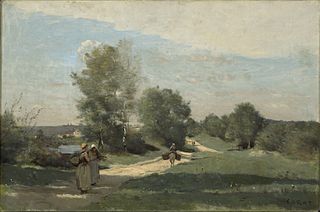
The Barbizon school of painters were part of an art movement toward Realism in art, which arose in the context of the dominant Romantic Movement of the time. The Barbizon school was active roughly from 1830 through 1870. It takes its name from the village of Barbizon, France, on the edge of the Forest of Fontainebleau, where many of the artists gathered. Most of their works were landscape painting, but several of them also painted landscapes with farmworkers, and genre scenes of village life. Some of the most prominent features of this school are its tonal qualities, color, loose brushwork, and softness of form.

Albert Pinkham Ryder was an American painter best known for his poetic and moody allegorical works and seascapes, as well as his eccentric personality. While his art shared an emphasis on subtle variations of color with tonalist works of the time, it was unique for accentuating form in a way that some art historians regard as modernist.

Carlo Crivelli was an Italian Renaissance painter of conservative Late Gothic decorative sensibility, who spent his early years in the Veneto, where he absorbed influences from the Vivarini, Squarcione, and Mantegna. He left the Veneto by 1458 and spent most of the remainder of his career in the March of Ancona, where he developed a distinctive personal style that contrasts with that of his Venetian contemporary Giovanni Bellini.

Charles Ephraim Burchfield was an American painter and visionary artist, known for his passionate watercolors of nature scenes and townscapes. The largest collection of Burchfield's paintings, archives and journals are in the collection of the Burchfield Penney Art Center in Buffalo. His paintings are in the collections of more than 109 museums in the USA and have been the subject of exhibitions at the Metropolitan Museum of Art, the Whitney Museum of American Art, the Hammer Museum, and the Museum of Modern Art, as well as other prominent institutions.
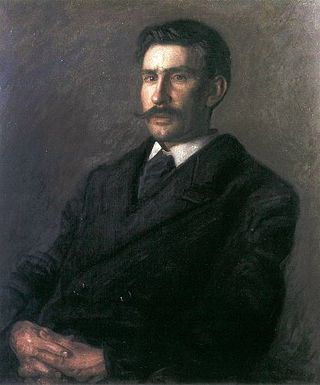
Edward Willis Redfield was an American Impressionist landscape painter and member of the art colony at New Hope, Pennsylvania. He is best known today for his impressionist scenes of the New Hope area, often depicting the snow-covered countryside. He also spent his summers on Boothbay Harbor, Maine, where he interpreted the local coastline. He frequently painted Maine's Monhegan Island.
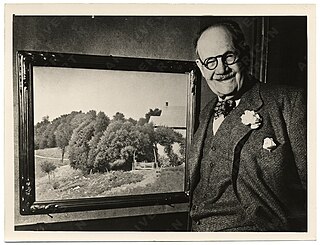
Frank Vincent DuMond was one of the most influential teacher-painters in 20th-century America. He was an illustrator and American Impressionist painter of portraits and landscapes, and a prominent teacher who instructed thousands of art students throughout a career spanning over fifty years.

James Augustus Suydam was an American architect, lawyer, and artist; as an artist was considered one of the premier Luminism painters. He is widely known as an American landscape painter and one of the leading members of the Hudson River School.

Michelino Molinari da Besozzo was a notable fifteenth century Italian painter and illuminator, who was widely praised for his work. He worked mostly in Milan and Lombardy, and was employed by the Visconti family, rulers of Milan. Michelino's work follows the traditions of the Lombard School, and maintains the Trecento style.

A Goldsmith in His Shop is a 1449 painting by Petrus Christus, a leading painter in Bruges. It is now in the Metropolitan Museum of Art. This is an oil painting on an oak panel that measures 100.1 x 85.8 cm overall and the painted surface is 98 x 85.2 cm. An inscription at the bottom of the painting states "m petr[vs] xpi me· ·fecit·ao 1449· ". In addition, the inscription has an emblem of a clock with a mechanical linkage to a heart, Christus's emblem.

George Henry Yewell was an American painter and etcher.

Louis Rémy Mignot was an American painter of Catholic descent. Associated with the Hudson River School of landscape artists, his southern US heritage and the influence of his time spent in Europe gave him a distinct style within that group, in painting vegetation and atmospheric effects.
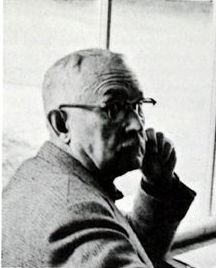
Meyric R. Rogers (1893–1972) was an Anglo-American curator and design historian.



















